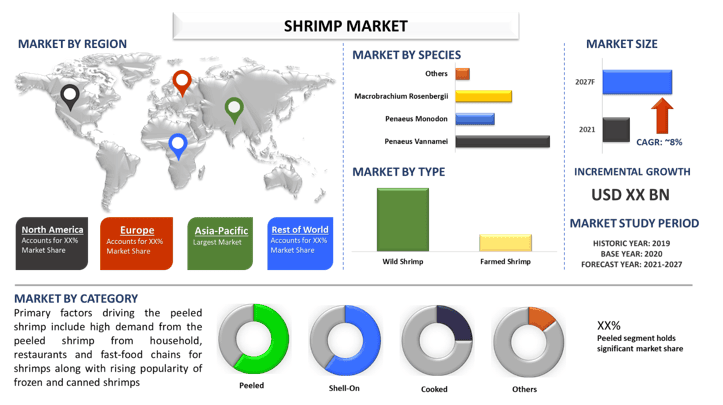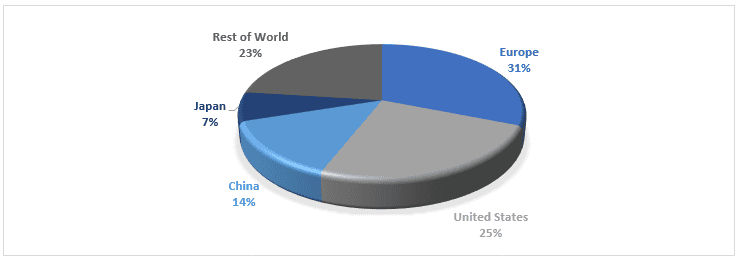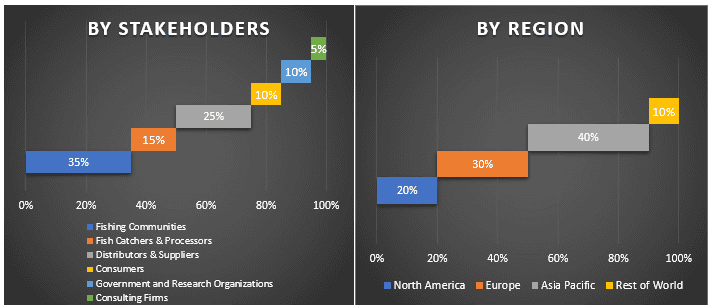 預計蝦類市場在預測期內(2021-2027 年)將以約 8% 的複合年增長率增長。蝦是蛋白質、硒和維生素 B12 的豐富來源。此外,它們還含有高濃度的磷和鐵。此外,發展中地區的政府已採取多項措施來升級技術,以提高蝦養殖場的投入,預計這將有助於小型產業,並幫助參與該產業發展過程中的弱勢族群,從而推動蝦類市場的成長。
預計蝦類市場在預測期內(2021-2027 年)將以約 8% 的複合年增長率增長。蝦是蛋白質、硒和維生素 B12 的豐富來源。此外,它們還含有高濃度的磷和鐵。此外,發展中地區的政府已採取多項措施來升級技術,以提高蝦養殖場的投入,預計這將有助於小型產業,並幫助參與該產業發展過程中的弱勢族群,從而推動蝦類市場的成長。
推動蝦類市場成長的主要因素和蝦類市場趨勢包括蝦類的易於取得及其高營養成分。作為海鮮中最常交易的物種之一,它們是各種美食的重要組成部分。觀察到的主要趨勢之一是食品產業的擴張,這是由於對即食食品的需求增加所致。
2020 年的總產量預計與往年持平,儘管 Covid-19 疫情的爆發對全球蝦類的需求以及生產造成了影響,但該年仍呈現溫和成長。通常,天氣模式、疾病爆發、價格波動等幾個外部因素已經導致了產業參與者的生產、需求和利潤的不可預測性。
主要蝦類進口國的市佔率 (%)
在市場上營運的一些主要參與者包括 Aqua Star Corp.、Mazzetta Company, LLC、Clearwater Seafoods Inc.、Thai Union Group、Nordic Seafood A/S、Apex Frozen Foods Ltd.、Seaprimexco Vietnam、Grupo Iberica Congelados, S.A、High Liner Foods Inc.、Charoen Pokphand Foods PCL 等。這些參與者已經進行了幾項併購以及合作夥伴關係,以提高他們在不同地區的影響力。
報告中提供的洞察
「在類型中,野生蝦類在 2020 年主導了市場」
依類型劃分,蝦類市場分為野生蝦類和養殖蝦類。野生蝦類在蝦類市場中佔據最高的市場佔有率,預計在預測期內將持續成長。這種成長歸因於廣泛的供應。
此外,全球養殖蝦類市場的成長速度持續快於其他水產養殖物種,大多數蝦類在亞洲生產。亞洲以外的主要市場是拉丁美洲,厄瓜多最近超越泰國成為世界第五大蝦類生產國。全球養殖蝦類市場的成長速度持續快於其他水產養殖物種,大多數蝦類在亞洲生產。
「在物種中,南美白對蝦 在 2020 年主導了市場。」
依物種劃分,蝦類市場分為南美白對蝦、斑節對蝦、羅氏沼蝦、其他。南美白對蝦在 2020 年佔據了較大的市場佔有率,預計在預測期內將呈現顯著的成長率。
在全球範圍內,主要的蝦類生產國包括阿根廷、中國、厄瓜多、印度、印尼、泰國和越南。2016 年,中國南美白對蝦的海水養殖產量為 932,297 噸,比 2015 年增加 39,115 噸,意味著成長了 4.38%。到 2019 年,中國南美白對蝦的海水養殖產量為 1,144,370 噸,比 2018 年增加 26,836 噸,成長了 2.4%。 此外,南美白對蝦含有 ω-9 脂肪酸,有助於降低動脈硬化、心血管疾病和中風的風險。根據結果,L. vannamei 物種可以被認為是脂肪酸和蛋白質的良好來源。
「在類別中,去殼蝦在 2020 年佔有顯著的市場佔有率。」
在類別中,蝦類市場分為去殼蝦、帶殼蝦、熟蝦和其他。去殼蝦在 2020 年主導了蝦類市場,預計在預測期內仍將是領先的類別。推動去殼蝦的主要因素包括來自家庭、餐廳和速食連鎖店對去殼蝦的高需求,以及冷凍和罐裝蝦的日益普及。
「在經銷通路中,專賣店 在 2020 年佔有顯著的市場佔有率。」
依經銷通路劃分,蝦類市場分為大型超市和超級市場、專賣店、旅館和餐廳、線上和其他。專賣店為蝦類市場貢獻了最多的收入。這歸因於專賣店提供折扣等選擇以及立即獲得滿足的好處。
「亞太地區是最大的市場。」
為了更好地了解蝦類市場的採用情況,我們分析了北美(美國、加拿大、北美其他地區)、歐洲(德國、英國、法國、荷蘭、歐洲其他地區)、亞太地區(中國、日本、印尼、印度、泰國、亞太地區其他地區)和世界其他地區等國家/地區的市場。亞太地區在 2020 年主導了市場。中國、印度、印尼、孟加拉、菲律賓、泰國和越南等亞洲國家/地區透過創造蝦類市場機會而佔據了很大的市場佔有率,從而導致亞洲國家/地區主導了市場。亞洲國家/地區擁有廣闊的沿海地帶、周圍環境和溫度來養殖蝦類,自 1990 年代水產養殖生產方法蓬勃發展以來,這些地區已在世界蝦類生產中佔據領先地位。這些國家的國內消費多樣化,中國和其他東南亞國家/地區的人均蝦類需求相對較大。在國內消費之後,他們將減少向其他地區供應的庫存。另一方面,印度的蝦類消費量較低,並且將其產量的 80% 以上出口到世界各地的主要市場。
購買本報告的理由:
- 該研究包括經授權的主要產業專家驗證的市場規模和預測分析
- 該報告簡要回顧了整個產業的整體表現
- 該報告深入分析了傑出的產業同業,主要關注關鍵業務財務、產品組合、擴張策略和最新發展
- 詳細檢查產業中普遍存在的驅動因素、限制、關鍵趨勢和機會
- 該研究全面涵蓋了跨不同領域的市場
- 深入的產業區域和國家層級分析
客製化選項:
蝦類市場可以根據需求或任何其他市場區隔進一步客製化。除此之外,UMI 了解您可能有自己的業務需求,因此請隨時與我們聯繫以取得一份完全符合您需求的報告。
目錄
分析歷史市場、估計當前市場以及預測蝦類市場的未來,是為創建和分析全球各個地區蝦類的生產、出口和進口、消費所採取的三个主要步驟。進行了詳盡的二級研究,以收集歷史市場數據並估計當前市場規模。其次,為了驗證這些見解,考慮了眾多的發現和假設。此外,與行業價值鏈中的行業專家進行了詳盡的初步訪談。在通過初步訪談對市場數據進行假設和驗證後,我們採用了自上而下/自下而上的方法來預測完整的市場規模。此後,採用市場細分和數據三角驗證方法來估計和分析行業所屬的細分市場和子細分市場的規模。詳細的方法論如下所述。
歷史市場規模分析
步驟 1:深入研究二級來源:
進行了詳細的二級研究,以通過公司內部來源(例如年度報告和財務報表、投資者演示文稿、新聞稿等)以及外部來源(包括期刊、新聞和文章、政府出版物、競爭對手出版物、行業報告、第三方數據庫和其他可靠的出版物)獲取蝦類的歷史市場規模。
步驟 2:市場細分:
在獲得蝦類的歷史市場規模後,我們進行了詳細的二級分析,以收集主要地區不同細分市場和子細分市場的歷史市場見解和份額。報告中包含的主要細分市場包括類型、品種、類別和分銷渠道。此外,還進行了區域和國家層面的分析,以評估全球範圍內蝦類市場的總體採用情況。
步驟 3:因素分析:
在獲得不同細分市場和子細分市場的歷史市場規模後,我們進行了詳細的因素分析,以估計當前市場規模。此外,我們使用自變量和因變量進行了因素分析,例如人口增長、個人生活水平提高、可支配收入增加、對冷凍蝦產品的需求以及蝦的各種健康益處等。分析了歷史趨勢及其對市場規模和份額的逐年影響。還徹底研究了需求和供應方面的情況。
當前市場規模估計與預測
當前市場規模:根據上述 3 個步驟中可行的見解,我們得出了當前市場規模、市場中的主要參與者以及細分市場和公司的市場份額。所有必需的百分比拆分和市場細分均使用上述二級方法確定,並通過初步訪談進行驗證。
估計與預測:對於市場估計和預測,權重被分配給不同的因素,包括驅動因素和趨勢、限制因素以及利益相關者可獲得的機會。在分析這些因素後,應用了相關的預測技術,即自上而下/自下而上的方法,以得出到 2027 年全球主要地區不同細分市場和子細分市場的市場預測。用於估計市場規模的研究方法包括:
- 該行業的市場規模,按價值(美元)計算
- 市場細分和子細分的全部百分比份額、拆分和細分
- 蝦類市場在生產、出口和進口方面的主要參與者。此外,這些參與者為在快速增長的市場中競爭而採取的增長策略。
市場規模和份額驗證
初步研究:與主要意見領袖 (KOL)(包括主要國家/地區的最高級主管(CXO/VP、銷售主管、營銷主管、運營主管以及區域主管、國家主管等))進行了深入的訪談。然後對初步研究結果進行了總結,並進行了統計分析以證明所述假設。初步研究的輸入與二級研究結果相結合,從而將信息轉化為可行的見解。
不同地區的主要參與者分配
市場工程
採用數據三角驗證技術來完成整體市場估計,並得出蝦類市場每個細分市場和子細分市場的精確統計數據。在研究了全球主要國家/地區類型、品種、類別和分銷渠道等領域的各種參數和趨勢後,將數據分為多個細分市場和子細分市場。
蝦類市場研究的主要目標
研究中精確指出了蝦類當前和未來的市場趨勢。投資者可以從研究中執行的定性和定量分析中獲得戰略見解,以作為其投資決定的基礎。當前和未來的市場趨勢將決定區域和國家層面市場的總體吸引力,從而為行業參與者提供一個利用未開發市場以從先發優勢中受益的平台。研究的其他定量目標包括:
- 分析蝦類當前和預測的市場規模,按價值(美元)計算。此外,分析不同細分市場和子細分市場的當前和預測的市場規模
- 研究中的細分市場包括類型、品種、類別和分銷渠道
- 分析主要地區和國家/地區蝦類當前和預測的市場規模
- 報告中研究的主要區域包括北美(美國、加拿大、北美其他地區)、歐洲(德國、英國、法國、荷蘭、歐洲其他地區)、亞太地區(中國、日本、印度尼西亞、印度、泰國、亞太地區其他地區)和世界其他地區
- 蝦類市場參與者的公司概況以及他們為在快速增長的市場中維持生存而採取的增長策略
深入分析行業的區域和國家層面
相關 報告
購買此商品的客戶也購買了










